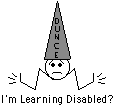HOW we were taught to learn and how that can discourage creativity
Early on in our formal education we are taught to think linearly - ABC - 123 - and often in discrete increments. When asked to "recite the alphabet" it's assumed that you HAVE TO start with A and end with Z. But why is starting with N then Q, followed by D and so on until ALL the letters have been recited - discouraged? It would demonstrate that the person "reciting" all of the alphabet in fact knew all the letters of the alphabet. Of course, it would also make it more difficult for the teacher to confirm that fact - but there could be ways developed to take care of that issue. But - "in school" today, anything other than A-B-C . . . X - Y - Z and 1,2,3 - 10 is considered WRONG - and stronlgy discouraged.

If told to count from 1 to 10, the kid who says "One, one and a quarter, one and a half, two, three, three and a third, four . . . TEN!" gets cut off at "one and a quarter". The "correct answer" is 1,2,3 . . . 9, 10.
And the kid who doesn't color "within the lines" . . . often gets labeled as having a "learning disability" - in the old days he/she would be called A Dunce.

To a large extent, because of the way we were taught to think is linear, we tend to apply that approach to things that don't require "staying within the lines" - so we don't even consider thinking "outside the box". Those that CAN follow The Rules, but DON'T, are often labeled "children with special needs" early on, and later labeled as criminal masterminds - or innovators - or artists.

Yet most of us CAN learn to be "creative" - or more correctly - most of us can unlearn how NOT to be "creative".
Let's use a woodworking project as an example - and confine the project primarily to making a turned piece since turning is a relatively quick process and doesn't - normally - require a lot of wood or a shop full of tools and machines.
One approach would be to start with a specific piece in mind (E) and work backwards to a procedure and techniques that will get you to (E), starting at (A). The piece might be one we've seen somewhere - a picture in a magazine or on the web, something we saw in a store or gallery or in a movie. It defines WHERE we want to go.
![]()
Another approach could be to start with a technique or a machining procedure and develop a piece that exploits that technique or those machines and procedures. Again, we've got some possible WHEREs sort of in mind. If you begin with the idea of playing with inlaying the obvious destinations are somewhat finite. (but inlaying a pattern of some sort - out of wood - in a painting - might be interesting.), We start FROM (A) and work TOWARDS (E).
![]()
Both of these approaches are basically linear, only the direction is changed - either start at (A) and step through to (E) or start with (E) and work backwards to (A). But staying On The Line, or Within The Lines, or even On The Paper is kind of limiting